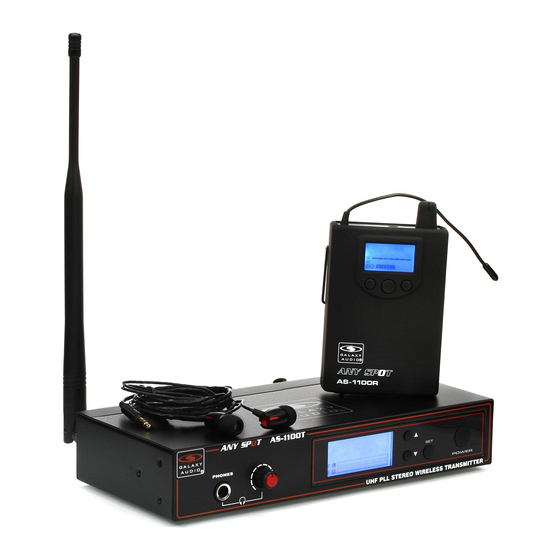Galaxy Audio Any Spot AS-1100 Manuel de démarrage rapide - Page 2
Parcourez en ligne ou téléchargez le pdf Manuel de démarrage rapide pour {nom_de_la_catégorie} Galaxy Audio Any Spot AS-1100. Galaxy Audio Any Spot AS-1100 2 pages. Wireless personal monitor
Également pour Galaxy Audio Any Spot AS-1100 : Manuel de l'utilisateur (9 pages), Manuel de l'utilisateur (9 pages)

AS-1100
Wireless Personal Monitor
Other Helpful Sources
AS-1100
Product Page
AS-1100
Cutsheet
(PDF Download)
601 E. Pawnee Wichita,
Distributed in Canada by Audio Distributors International (ADI) 1275 Newton, unit 6 Boucherville, QC J4B 5H2 Canada
Distributed outside the United States by TradeLink America, LLC. 230 Kings Mall Ct., Suite 182 Kingston, NY 12401
Quick Start Guide
AS-1100
Manual
(PDF Download)
AS-1100
How To Video
Specifications subject to change without notice.
KS
67211 316. 263.2852
FAX
316.263.0642 www.galaxyaudio.com
450.449.8177 FAX 450.449.8180
[email protected] TEL 1.845.246.6200 FAX 1.845.746.9070
Printed in China
V20170504
FAQ
1.
Q. I only have one Aux output available on my mixer, and the sound is only in one ear.
A. On the back of the transmitter, you will see a "MONO / STEREO" switch, move it to the appropriate mode.
2.
Q. How many receivers can I use?
A. It is unlimited. Use as many as you need.
3.
Q. Can you have more than 1 mix?
A. You will need another AS-900 system on a different frequency for each mix.
4.
Q. Can I use ear buds other than the supplied EB4?
A. Yes, you can use any headphone or ear bud with an impedance of 16 ohms or higher.
The frequencies of the Galaxy UHF Wireless Systems are on frequencies that are used by Digital Television stations.
To be assured of the best performance, you should determine on what RF channels the DTV stations
in your area are broadcasting, then set your wireless systems on frequencies that are not being used.
For more information, please view the DTV Frequency Ranges & FCC Consumer Alert online at:
TM
Wireless Tips
Maintain line of sight between the transmitter and receiver antennas.
Do not have walls, metal objects, large crowds, etc. blocking the line of sight between the transmitter and receiver.
Antennas on the stationary equipment should be kept several feet above the ground.
Antennas can be mounted on stands or walls using brackets such as the ANT-LB.
On body pack receivers/transmitters, avoid putting them in your pocket, and/or folding the antenna under the pack.
The antenna should hang freely and openly.
Keep the distance between transmitters and receivers as short as possible.
If distances above 20-30' are unavoidable, directional antennas such as the ANT-PDL can improve reception by
rejecting signals outside their pickup angle.
Find out what TV stations are broadcasting in your area and avoid the channels they are on.
This information is available from many sources on line, such as www.tvfool.com.
If your receiver is showing that it is receiving RF when your transmitter is turned off, you need to move to another
frequency.
If you are using several systems, you can contact [email protected] for assistance in
frequency coordination.
Make certain you are using fresh batteries, rechargeable batteries may be used, but they discharge at a much
faster rate than alkaline.
galaxyaudio.com/support/schematics-and-frequency-charts
